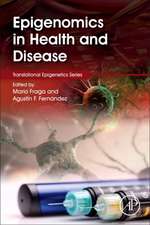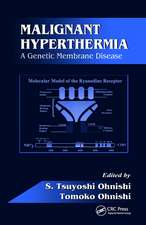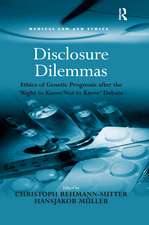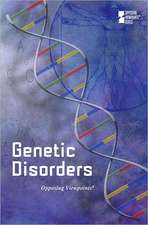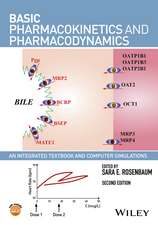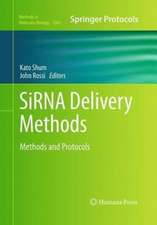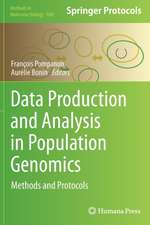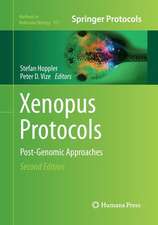Genome Editing: The Next Step in Gene Therapy: Advances in Experimental Medicine and Biology, cartea 895
Editat de Toni Cathomen, Matthew Hirsch, Matthew Porteusen Limba Engleză Paperback – 8 apr 2018
Genome Editing: The Next Step in Gene Therapy, the latest volume in the American Society of Gene and Cell Therapy series, deftly illuminates the potential of genetic engineering technology to eradicate today’s deadliest and most prolific diseases. It is ideal reading for clinicians and researchers in genetics and immunology.
| Toate formatele și edițiile | Preț | Express |
|---|---|---|
| Paperback (1) | 1030.27 lei 6-8 săpt. | |
| Springer – 8 apr 2018 | 1030.27 lei 6-8 săpt. | |
| Hardback (1) | 1037.21 lei 6-8 săpt. | |
| Springer – 5 mar 2016 | 1037.21 lei 6-8 săpt. |
Din seria Advances in Experimental Medicine and Biology
- 9%
 Preț: 719.56 lei
Preț: 719.56 lei - 5%
 Preț: 717.00 lei
Preț: 717.00 lei - 5%
 Preț: 717.00 lei
Preț: 717.00 lei - 15%
 Preț: 640.24 lei
Preț: 640.24 lei - 5%
 Preț: 715.71 lei
Preț: 715.71 lei - 5%
 Preț: 716.28 lei
Preț: 716.28 lei - 20%
 Preț: 691.93 lei
Preț: 691.93 lei - 5%
 Preț: 1031.00 lei
Preț: 1031.00 lei - 5%
 Preț: 820.42 lei
Preț: 820.42 lei - 5%
 Preț: 716.28 lei
Preț: 716.28 lei - 15%
 Preț: 641.38 lei
Preț: 641.38 lei - 5%
 Preț: 717.20 lei
Preț: 717.20 lei - 5%
 Preț: 715.35 lei
Preț: 715.35 lei - 5%
 Preț: 1113.83 lei
Preț: 1113.83 lei - 20%
 Preț: 1161.71 lei
Preț: 1161.71 lei - 5%
 Preț: 1170.51 lei
Preț: 1170.51 lei - 18%
 Preț: 1119.87 lei
Preț: 1119.87 lei - 5%
 Preț: 1288.48 lei
Preț: 1288.48 lei - 5%
 Preț: 1164.67 lei
Preț: 1164.67 lei - 5%
 Preț: 1101.73 lei
Preț: 1101.73 lei - 18%
 Preț: 1123.67 lei
Preț: 1123.67 lei - 5%
 Preț: 1435.64 lei
Preț: 1435.64 lei - 20%
 Preț: 1044.10 lei
Preț: 1044.10 lei - 18%
 Preț: 946.39 lei
Preț: 946.39 lei - 5%
 Preț: 292.57 lei
Preț: 292.57 lei - 18%
 Preț: 957.62 lei
Preț: 957.62 lei - 18%
 Preț: 1235.76 lei
Preț: 1235.76 lei - 5%
 Preț: 1231.55 lei
Preț: 1231.55 lei - 5%
 Preț: 1292.30 lei
Preț: 1292.30 lei - 5%
 Preț: 1102.10 lei
Preț: 1102.10 lei - 18%
 Preț: 1132.81 lei
Preț: 1132.81 lei - 5%
 Preț: 1165.19 lei
Preț: 1165.19 lei - 5%
 Preț: 1418.48 lei
Preț: 1418.48 lei - 5%
 Preț: 1305.63 lei
Preț: 1305.63 lei - 18%
 Preț: 1417.72 lei
Preț: 1417.72 lei - 18%
 Preț: 1412.99 lei
Preț: 1412.99 lei - 24%
 Preț: 806.15 lei
Preț: 806.15 lei - 18%
 Preț: 1243.29 lei
Preț: 1243.29 lei - 5%
 Preț: 1429.44 lei
Preț: 1429.44 lei - 5%
 Preț: 1618.70 lei
Preț: 1618.70 lei - 5%
 Preț: 1305.12 lei
Preț: 1305.12 lei - 18%
 Preț: 1124.92 lei
Preț: 1124.92 lei - 5%
 Preț: 1097.54 lei
Preț: 1097.54 lei - 15%
 Preț: 649.87 lei
Preț: 649.87 lei - 5%
 Preț: 1097.54 lei
Preț: 1097.54 lei - 18%
 Preț: 945.79 lei
Preț: 945.79 lei - 5%
 Preț: 1123.13 lei
Preț: 1123.13 lei - 20%
 Preț: 816.43 lei
Preț: 816.43 lei
Preț: 1030.27 lei
Preț vechi: 1084.49 lei
-5% Nou
Puncte Express: 1545
Preț estimativ în valută:
197.17€ • 204.28$ • 164.55£
197.17€ • 204.28$ • 164.55£
Carte tipărită la comandă
Livrare economică 21 martie-04 aprilie
Preluare comenzi: 021 569.72.76
Specificații
ISBN-13: 9781493980611
ISBN-10: 1493980610
Ilustrații: XVI, 263 p. 48 illus., 43 illus. in color.
Dimensiuni: 155 x 235 mm
Greutate: 0.4 kg
Ediția:Softcover reprint of the original 1st ed. 2016
Editura: Springer
Colecția Springer
Seriile Advances in Experimental Medicine and Biology, American Society of Gene & Cell Therapy
Locul publicării:New York, NY, United States
ISBN-10: 1493980610
Ilustrații: XVI, 263 p. 48 illus., 43 illus. in color.
Dimensiuni: 155 x 235 mm
Greutate: 0.4 kg
Ediția:Softcover reprint of the original 1st ed. 2016
Editura: Springer
Colecția Springer
Seriile Advances in Experimental Medicine and Biology, American Society of Gene & Cell Therapy
Locul publicării:New York, NY, United States
Cuprins
1. Gene Editing: Double-StrandBreak Induced Gene Targeting and Mutagenesis 20 Years Later.- 2. TheDevelopment and Use of Zinc-Finger Nucleases.- 3.The Use and Development of TALEffector Nucleases.- 4. Genome Editing for Neuromuscular Diseases.- 5. PhageIntegrases for Genome Editing.- 6. Precise Genome Modification Using TriplexForming Oligonucleotides and Peptide Nucleic Acids.- 7. Genome Editing byAptamer-Guided Gene Targeting.- 8. Stimulation of AAV Gene Editing via DSBRepair.- 9. Engineered Nucleases and Trinucleotide Repeat Diseases.- 10. UsingEngineered Nucleases to Create HIV-Resistant Cells.- 11. Strategies toDetermine Off-Target Effects of Engineered Nucleases.
Notă biografică
Matthew Hirsch, PhD is an Assistant Professor of Ophthalmology at the University of North Carolina (UNC) at Chapel Hill in Chapel Hill, North Carolina. He also holds appointments in Microbiology and Immunology and in Genetics and MolecularBiology, as well as in the Gene Therapy Center at UNC. Dr. Hirsch received his PhD from West Virginia University in Morgantown, WV; his studies focused on E.coli and Salmonella genetics. He completed his post-doctoral research at UNC studying both episomal and chromosomal genetic engineering using adeno-associated virus (AAV). Dr. Hirsch continues these basic AAV studies and has several reagents under preclinical evaluation for the treatment ofblindness and muscular dystrophies.
Toni Cathomen, PhD is Professor and Director of the Institute for Cell and Gene Therapy at the University Medical Center Freiburg, in Freiburg, Germany. The Institute provides the Medical Center with blood and cell products as well as all transfusion and transplantation related diagnostic services. Dr. Cathomen received his PhD from the University of Zurich, in Zurich, Switzerland. Before his appointment in Freiburg, he was a postdoctoral fellow at the Salk Institute in San Diego, California, USA; Assistant Professor of Molecular Virology at Charité Medical School in Berlin, Germany; and Associate Professor of Experimental Hematology at Hannover Medical School in Hannover, Germany. Dr. Cathomen’smain research goals are to further improve safe genome editing tools (including TALENs, CRISPR/Cas9) for therapeutic applications in human stem cells, to develop disease models and cell therapies based on induced pluripotent stem cells (iPSCs), and to translate cell and gene therapy efforts into the clinic.
Dr. Matthew Porteus is an Associate Professor at Stanford Medical School in Stanford, California, and attends clinically at the Lucille Packard Children’s Hospital in Palo Alto, California. Dr.Porteusreceived a combined MD, PhD from Stanford Medical School. After completing a fellowship with the Boston Children’s Hospital in conjunction with the Dana Farber Cancer Institute, both in Boston, Massachusetts, he did post-doctoral research at both the Massachusetts Institute of Technology in Cambridge, Massachusetts and the California Institute of Technology in Pasadena, California. Following these, heheld an independent faculty position at University of Texas- Southwestern in Dallas, Texas in the Departments of Pediatrics and Biochemistry before assuming his current position. In his research, Dr. Porteus focuses on the development of genome editing by homologous recombination as curative therapy for children with genetic diseases. He is also interested in the clonal dynamics of heterogeneous populations and the use of genome editing to better understand pediatric disease, including infant leukemias and muscular genetic disorders.
Toni Cathomen, PhD is Professor and Director of the Institute for Cell and Gene Therapy at the University Medical Center Freiburg, in Freiburg, Germany. The Institute provides the Medical Center with blood and cell products as well as all transfusion and transplantation related diagnostic services. Dr. Cathomen received his PhD from the University of Zurich, in Zurich, Switzerland. Before his appointment in Freiburg, he was a postdoctoral fellow at the Salk Institute in San Diego, California, USA; Assistant Professor of Molecular Virology at Charité Medical School in Berlin, Germany; and Associate Professor of Experimental Hematology at Hannover Medical School in Hannover, Germany. Dr. Cathomen’smain research goals are to further improve safe genome editing tools (including TALENs, CRISPR/Cas9) for therapeutic applications in human stem cells, to develop disease models and cell therapies based on induced pluripotent stem cells (iPSCs), and to translate cell and gene therapy efforts into the clinic.
Dr. Matthew Porteus is an Associate Professor at Stanford Medical School in Stanford, California, and attends clinically at the Lucille Packard Children’s Hospital in Palo Alto, California. Dr.Porteusreceived a combined MD, PhD from Stanford Medical School. After completing a fellowship with the Boston Children’s Hospital in conjunction with the Dana Farber Cancer Institute, both in Boston, Massachusetts, he did post-doctoral research at both the Massachusetts Institute of Technology in Cambridge, Massachusetts and the California Institute of Technology in Pasadena, California. Following these, heheld an independent faculty position at University of Texas- Southwestern in Dallas, Texas in the Departments of Pediatrics and Biochemistry before assuming his current position. In his research, Dr. Porteus focuses on the development of genome editing by homologous recombination as curative therapy for children with genetic diseases. He is also interested in the clonal dynamics of heterogeneous populations and the use of genome editing to better understand pediatric disease, including infant leukemias and muscular genetic disorders.
Textul de pe ultima copertă
Thiscomprehensive volume explores human genetic engineering its pre-clinical andclinical applications, current developments, and as treatment for hereditarydiseases. It presents and evaluates the most recent advances in theunderstanding of mammalian host DNA repair mechanisms, such as double-strandbreak induced gene targeting and mutagenesis, the development of zinc-fingernucleases, genome editing for neuromuscular diseases, phase integrases, triplexforming oligonucleotides and peptide nucleic acids, aptamer-guided genetargeting, AAV gene editing via DSB repair, engineered nucleases andtrinucleotide repeat diseases, and creation of HIV-resistant cells. Theexpertly authored chapters contextualize current developments within thehistory of genome editing while also discussing the current and potentialsafety concerns of this rapidly growing field. Genome Editing: The Next Step in Gene Therapy, the latestvolume in the American Society of Gene and Cell Therapy series, deftly illuminates thepotential of genetic engineering technology to eradicate today’s deadliest andmost prolific diseases. It is ideal reading for clinicians and researchers ingenetics and immunology.
Caracteristici
Will present most recent advances in the basic understanding of mammalian host DNA repair mechanisms Reviews the most promising approaches to stimulate high efficiency gene editing Also focuses on gene editingapplications in the clinic? Includes supplementary material: sn.pub/extras




